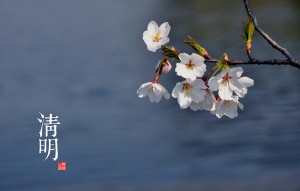 The traditional Chinese lunar calendar divides the year into 24 solar terms. Clear and Bright (Chinese: 清明), the 5th solar term.
The traditional Chinese lunar calendar divides the year into 24 solar terms. Clear and Bright (Chinese: 清明), the 5th solar term.
Of all the 24 solar terms, Clear and Bright is the only one whose first day is also a traditional Chinese festival, Tomb-Sweeping Day. The words “clear” and “bright” describe the weather during this period. Temperatures begin to rise and rainfall increases, making it a crucial time for plowing and sowing in the spring.
This year’s Tomb-Sweeping Day coincides with Easter Day (2015), one of the oldest and most vital of Christian festivals celebrating the resurrection of Jesus Christ. For Christians, the dawn of Easter Sunday signifies new life and represents the peak of the Christian year.
The Clear and Bright Festival, also known more commonly as Ching Ming, is a day that people set out to sweep and dust the graves of their ancestors. They will also weed around the tombstones and repair any inscriptions that need work. It is a sign of respect to their elders. Many participants will also leave offerings, such as a piece of fruit or wine as an offering to their ancestors. Many people will use public transportation that follows the routes of the cemetery sites.
The word ching literally translated means “pure, clean.” The word ming means “brightness.” When the two words are combined, thus comes the Clear and Bright Festival. It is held some time in April every leap year. It is interesting to note that the Japanese have a similar holiday in their country as well.
The Origin of the Holiday
Many believe that the holiday originated out of Ancestor Worship, which is the only true religion that comes from China. Other religions such as Buddhism, Christianity, and others were brought in by other nations and adapted to the Chinese way of life and beliefs. While Confucianism and Taoism are Chinese-born practices, they are not solely religious, but have basis on philosophies of an un-religious nature as well. They are not considered true religion.
Incense and Imitation Money
The Chinese will light incense at their ancestors’ grave site, as well as burn imitation money. They burn the money in order to give it to their ancestors to spend in their afterlife. People will also burn other objects to offer to their ancestors as well. This is one part of the original festival that is still practiced in modern times.
Offerings and Rituals
Years ago families would set out an elaborate meal by the grave site to offer to their ancestors. The meal might have consisted of steamed chicken, hard boiled eggs, cha shiu (barbecue pork), roast pork, and other delectable foods, including dessert. Then three sets of chopsticks, along with three cups of wine, were placed above the layout of food and situated close to the head of the tombstone.
The head of a household was responsible for beginning the day’s events. Some men would set off fireworks to ward off evil spirits before the cleaning begins. Other men would start by bowing three times while holding a wine cup. He would then pour the wine out on the ground in front of the tombstone, and repeat this three times. Next, the rest of the family was invited to come and bow three times in front of the tombstone. They put their right fist cupped into their left hand when they bowed. The family then enjoyed the meal together right there at the grave site. It was believed to bring good luck to eat food offered to their ancestors.
Today, many families have made this part of the festival obsolete. They generally just clean the grave site, burn incense, and bring fresh flowers. Some families may still burn imitation money as well.
The Clear and Bright Festival is a time of respect to those who have passed from this life to the next. Most Chinese people are very certain that there is an afterlife, and that by taking care of their ancestors, they will have a happy afterlife, too.
The Clear and Bright Festival, also known more commonly as Ching Ming, is a day that people set out to sweep and dust the graves of their ancestors. It is held some time in April every leap year.
Here are 8 things you may not know about Clear and Bright.
Worshiping Ancestors
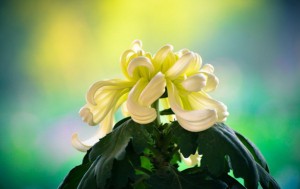 Clear and Bright is a period in which Chinese people honor nature and the ancestors of the Chinese nation. The worship of nature and ancestors can be traced to ancient times, and still matters a lot in modern society.
Clear and Bright is a period in which Chinese people honor nature and the ancestors of the Chinese nation. The worship of nature and ancestors can be traced to ancient times, and still matters a lot in modern society.
Cleaning the tombs and paying respect to the dead with offerings are the two important practices to remember late relatives. Weeds around the tomb are cleared away and fresh soil is added to show care for the dead.
The dead person’s favorite food, wine and chopsticks are offered on their tombs, along with paper money. These sacrifices are all burned in the hope that the deceased will not lack food and money in the afterlife.
Willow Branches
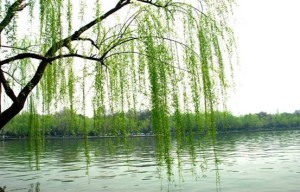 Legend has it that Clear and Bright is one of three periods during the year in which ghosts come closest to the world of living men. Buddhists believe that willow branches will drive away unwelcome ghosts and evil spirits. Therefore, willow branches are also known as “ghost terror wood.”
Legend has it that Clear and Bright is one of three periods during the year in which ghosts come closest to the world of living men. Buddhists believe that willow branches will drive away unwelcome ghosts and evil spirits. Therefore, willow branches are also known as “ghost terror wood.”
Folk proverbs also dictate customs. One proverb states that if a young lady does not wear a willow branch during the Clear and Bright period, she will soon turn old. Another says: “If one does not wear a willow, he will become a yellow dog after he dies and is reincarnated.”
Spring Outings
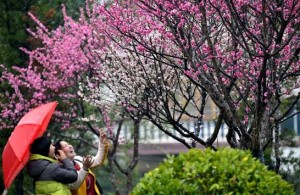 Not only is it a period for commemorating the dead, it is also time for people to go out and enjoy nature.
Not only is it a period for commemorating the dead, it is also time for people to go out and enjoy nature.
As trees turn green, flowers blossom, and the sun shines brightly, everything returns to life. It is a fine time to appreciate the beauty of nature. This custom can be traced back to the Spring and Autumn Period (770 – 476BC) and Warring States Period (475 – 221BC).
Strolling outside in spring adds joy to life and promotes a healthy body and mind.
Flying Kites
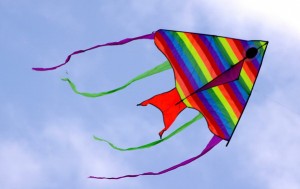 Flying kites is an activity favored by many Chinese during Tomb-Sweeping Day. Kites are not only flown during the day time but also in the evening. Little lanterns are tied to the kite or to the kitestring. And when the kites are flying in the sky, the lanterns look like twinkling stars at night. What makes flying kites during this day special is that people cut the string while the kite is in the sky to let it fly free. It is said this brings good luck and that diseases can be chased away by doing this.
Flying kites is an activity favored by many Chinese during Tomb-Sweeping Day. Kites are not only flown during the day time but also in the evening. Little lanterns are tied to the kite or to the kitestring. And when the kites are flying in the sky, the lanterns look like twinkling stars at night. What makes flying kites during this day special is that people cut the string while the kite is in the sky to let it fly free. It is said this brings good luck and that diseases can be chased away by doing this.
Cold Food Festival
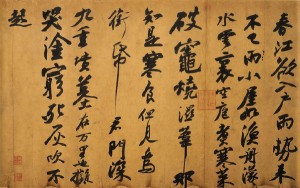
Huangzhou Han Shi Tie by Su Shi(part) It is a 34 x 119.5 cm hand scroll kept by the Taipei Palace Museum. It was written in 1082 when Su Shi was relegated to Huangzhou due to the literary inquisition. Impoverished and depressed, he produced this poem on the Cold Food Festival.
The Cold Food Festival or Hanshi Festival is a traditional Chinese holiday celebrated for one day before Tomb-Sweeping Day. On that day, making fire is taboo and only cold food is available.
Legend has it that Prince Chong’er of the state of Jin during the Spring and Autumn period, endured many hardships while he was exiled from his home state. Once, in order to help the prince who was tormented by hunger, Jie Zhitui cut off the flesh from his thigh and offered it to the prince for sustenance.
When Chong’er became Duke Wen of Jin, however, he did not reward him, instead killing Jie and his mother in a fire. Later, Duke Wen, filled with remorse, ordered that using fire on the anniversary of Jie’s death was forbidden and all food was to be consumed cold.
Cuju
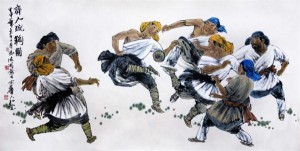 Cuju is an interesting game played during this period. Ju is a ball made of leather with hairs plugged in it. Legend has it that the Yellow Emperor first invented it for training warriors. Later, Cu Ju was used by people to build up their bodies when they were unable to eat hot food during the Cold Food Festival.
Cuju is an interesting game played during this period. Ju is a ball made of leather with hairs plugged in it. Legend has it that the Yellow Emperor first invented it for training warriors. Later, Cu Ju was used by people to build up their bodies when they were unable to eat hot food during the Cold Food Festival.
Eating Eggs
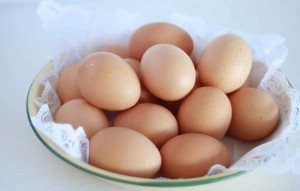 In many parts of China, eating eggs during Tomb-Sweeping Day is as important as eating moon cakes at Mid-Autumn Festival. The Chinese folk belief is that eating an egg on Tomb-Sweeping Day will bring good health all year. In China, this custom has lasted for thousands of years.
In many parts of China, eating eggs during Tomb-Sweeping Day is as important as eating moon cakes at Mid-Autumn Festival. The Chinese folk belief is that eating an egg on Tomb-Sweeping Day will bring good health all year. In China, this custom has lasted for thousands of years.
The origin of eating eggs dates back to “Shangsi Jie” (a traditional Chinese festival). In ancient times, women who want to have babies after marriage often colored boiled eggs with different colors and put them into the river, and people living in the lower reaches of the river picked the eggs up and ate them. It was said that the more eggs were eaten, the greater the chance the woman will get pregnant. Today, people believe that eating eggs on Tomb-Sweeping Day will bring success.
Feasting on Qingtuan
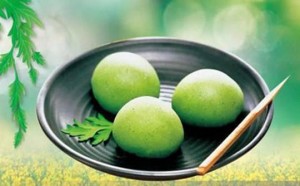 In the lower reaches of the Yangtze River region, qingtuan or green cake is very popular snack on Tomb-Sweeping Day. Qingtuan is a kind of round green cake. In order to make the cakes, people mash barnyard grass to squeeze juice from it and mix the flour and juice to a paste. Then they inject black bean filling into the paste and steam them. Pretty and delicate, Qingtuan have a mellow taste and special flavor. Qingtuan are also sacrificed to ancestors on Tomb-Sweeping Day.
In the lower reaches of the Yangtze River region, qingtuan or green cake is very popular snack on Tomb-Sweeping Day. Qingtuan is a kind of round green cake. In order to make the cakes, people mash barnyard grass to squeeze juice from it and mix the flour and juice to a paste. Then they inject black bean filling into the paste and steam them. Pretty and delicate, Qingtuan have a mellow taste and special flavor. Qingtuan are also sacrificed to ancestors on Tomb-Sweeping Day.
Did you know that if you subscribe to our website, you will receive email notifications whenever content changes or new content is added.
1. Enter your e-mail address below and click the Sign Me Up button.
2. You will receive an email asking you to confirm your intention of subscribing to our site.
3. Click the link in the email to confirm. That’s all there is to it! Note: if you wish to unsubscribe from our site, click the unsubscribe link at the bottom of the email you received.
Then indicate you no longer wish to receive our emails.
Thank You
Dialect Zone International